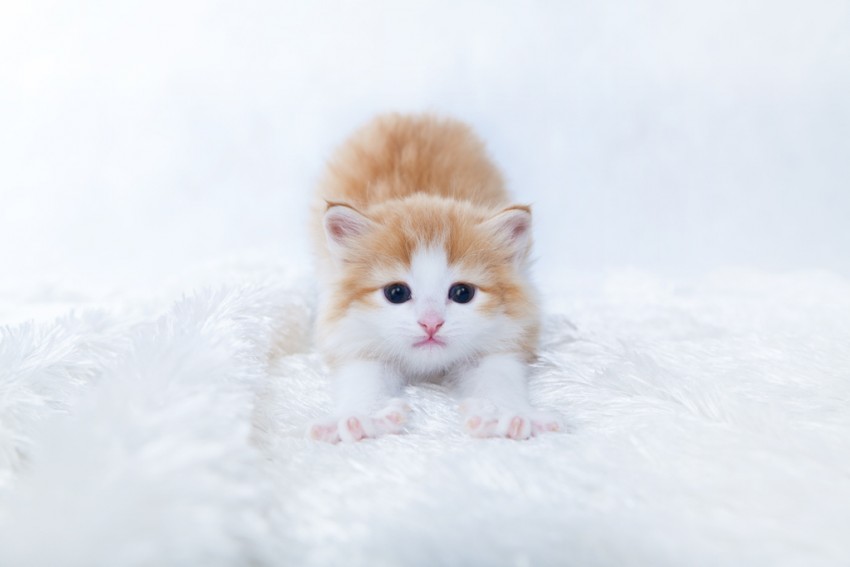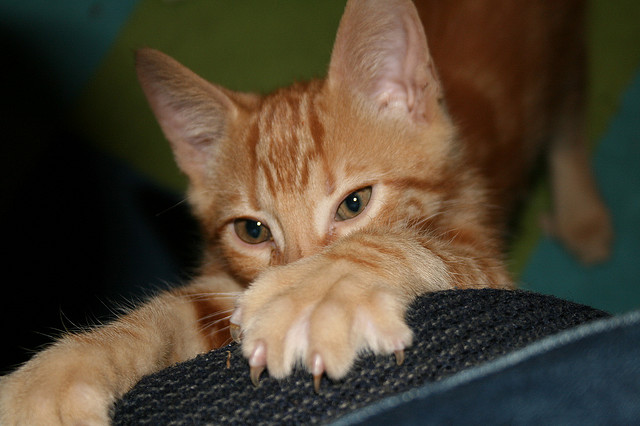
- Understanding Why Cats Scratch
- Common Issues with Cat-Scratching Posts
- Solutions to Cat-Scratching Problems
- Quick Solutions to Cat Scratching
- Training Your Cat to Use the Best Cat Scratching Post
- Preventing Furniture Scratching by Cats
- How to Build the Best Cat Scratching Post
- Tips for Choosing the Best Cat Scratching Post
- A Word About Declawing Cats
- Final Thoughts
- References
Understanding Why Cats Scratch
- If your cat scratches up your household, consider switching to microfiber furniture that holds up against your cat’s claws.
- One of the most common problems facing cat households is the cat’s love of scratching — everything.
- Scratching by cats can destroy furniture, causing cat lovers lots of grief.
Common Issues with Cat-Scratching Posts
Many people will go out and purchase a post for their kitty — only to learn, “My cat will not use the scratching post.”
Why Cats Scratch
According to Dr. Justine Lee, DVM, there are several reasons why cats are inclined to scratch.1
- First, they have scent glands under their paw pads, and scratching is a way of claiming their territory.
- Digging into furniture also feels good to cats because it allows them to stretch their muscles.
- It also is a form of exercise, keeping them in tip-top condition for hunting.2
- Another reason cats scratch is that it helps them wear down their nails.
Solutions to Cat-Scratching Problems
- First, be proactive. Recognize that you can’t fault your cat for doing something that’s as natural as breathing to them.
- Yelling or punishing her isn’t going to stop the scratching — the concept of punishment makes no sense to your cat.
- “She will only compute that sometimes when you catch her, she is treated badly,” says Dr. Christianne Schelling, DVM.3 “This may make her insecure and stimulate her to scratch more or develop other undesirable behavior problems.” And, eventually, you’ll end up losing the cat’s trust.
Quick Solutions to Cat Scratching
Two quick solutions to cat scratching:
- Trimming your cat’s nails often should help protect your furniture.
- Get a scratching post. Your cat needs a strong, sturdy place to scratch, with a surface they can sink their claws into.
A scratching post gives your cat a chance to exercise their muscles and keep their claws in check. But be sure that the post you buy has a secure base. “If it topples over even once,” says Dr. Schelling, your cat “won’t go back to it.”
Training Your Cat to Use the Best Cat Scratching Post
Here are 2 ways to train your cat to use a scratching post:
Method #1
- Entice your cat to the post by holding treats near it.
- Keep raising the treats higher, getting your cat to climb and capture them.
- Do this daily for a while, giving your cat some time to get used to the scratching post.
Method #2
- Instead of treats, try a favorite cat toy.
- Swing or dangle the toy around the scratching post so your cat will go up and down to retrieve it.
Additional Tips
- Some people use catnip as a training tool. Try sprinkling a little catnip on the surface of the scratching post and rub it in.
- You could also try placing the scratching post in the center of the room.
Furniture Alternatives for Cats
- If all else fails, you might consider switching to cat-friendly furniture.
- For example, microfiber fabrics hold up fairly well to punishment from cat scratching.4
When it comes to furniture protection, here are a couple more things you can do:
- Put sticky paws tape, which is double-sided, along the edges of your upholstered pieces. Cats definitely dislike its sticky feel. You’ll need to replace it every now and then, though, because it gets grungy over time.
- Never underestimate the power of a good throw/blanket. It will protect your chair or sofa and cover a multitude of claw marks. Old bed sheets work too, and they are easy to wash.

Preventing Furniture Scratching by Cats
Scratching is a natural instinct to cats. In the wild, scratching is a way to mark their territory. In addition, it removes layers of dead cells from their claws.
Here are a few ways to stop your cat from scratching up your furniture:
Provide approved surfaces.
Your cat can’t be trained to not scratch on your table legs or sofa arms.
So place a scratching post in a location that will catch your pet’s attention (perhaps sprinkling it with a bit of catnip, as we discussed above).
Sisal rope, wrapped tightly around the post, makes it almost as tough as a tree trunk, compared to carpet covering, which often snags claws.
According to cat expert Ingrid King, “Generally, sisal seems to be the most popular with cats, and it allows them to really go to town on shredding the material to pieces.”5
When your pet is using a climbing tree, make sure the tree is snugly secured so that it will not fall and cause injury.
Provide toys that stimulate and exercise.
Sound, smell, texture, and movement are all turn-ons to a cat’s curious nature. Offer a variety of playthings so your pet will not become easily bored. I personally like incline cardboard scratchers that have a cat toy built right into them.
A window perch can provide lots of enjoyment.
Just make sure the window is closed so your cat won’t fall out or go running after the bird or squirrel they’ve been eyeing. For more on window perches, see our article “Best Cat Window Perches.”
Cover your furniture with something your cat truly hates.
Many cats hate aluminum foil because of its sound and feel.
Plastic wrap is also an annoyance, as it clings to cats’ fur — but it can present a choking hazard, so please just save the plastic wrap for the kitchen.
Trim those nails regularly.
Trimming a cat’s nails deters scratching, or at least destructive cat scratching.
Get in the habit of trimming them — and start young.
Play gently with your kitten’s paws so that they gets used to them being touched. Then you can ease into trimming them a few at a time.
If you’ve adopted an adult cat, it’s going to be a lot trickier, especially if the cat is skittish.

How to Build the Best Cat Scratching Post
- Secure a 4-by-4-inch post, at least 3 feet long, to a 2-by-2-square-foot base. The board should be 1 inch thick.
- Wrap the post in the carpet, with the back side of the carpet facing out.
- Optionally, you can wrap the fabric around the carpeted post.
- Want a much more in-depth guide to building a sisal scratching post? Check out this one.
Here’s how to create a DIY scratching box for your cat (and maybe save some of your furniture):
Tips for Choosing the Best Cat Scratching Post
- Stability: Ensure the scratching post has a sturdy base to prevent it from toppling over. Cats will avoid unstable posts.
- Material: Opt for sisal rope or fabric, which are durable and satisfying for cats to scratch. Avoid carpet as it can snag claws.
- Height: Choose a post tall enough for your cat to fully stretch. This helps them exercise and stretch their muscles.
- Multiple Surfaces: Consider posts with different textures and surfaces to keep your cat engaged.
- Placement: Place the post in a location where your cat likes to scratch, such as near furniture they previously scratched.
A Word About Declawing Cats
You may have noticed that declawing, which may seem to be the simplest way of protecting furniture from your cat, was not included in this article.
Declawing is not only inhumane; it is an act of cruelty.
How would you like to have your finger cut off to the first knuckle because your instincts made you do something unfavorable? Declawing can cause both physical and psychological effects to your pet.
Soft Paws are a healthy, humane alternative. You glue them onto your cat’s front claws since, as Dr. Schelling points out, “these are what cause most of the destruction to your home.”
Most cats grow accustomed to Soft Paws pretty quickly. You shouldn’t put them on outdoor cats.
Also, please don’t resort to physical punishment in attempts to thwart your cat’s scratching behavior. This will only cause your pet to be afraid of you.
Final Thoughts
When your cat won’t use the scratching post, remember this: Kindness goes a long way in the training process.
Your love and patience, along with a few treats, could prove to your cat that a scratching post is a great gadget to have around.
Frequently Asked Questions (FAQ)
Why does my cat never use the scratching post?
Your cat may not use the scratching post because it prefers a different texture, location, or the post may be unstable.
How to encourage a cat to use a scratching post?
To encourage a cat to use a scratching post, place it in a prominent location and sprinkle it with catnip or use treats and toys to attract the cat.
How to get a feral cat to use a scratching post?
To get a feral cat to use a scratching post, introduce it gradually by placing it in a familiar area and using enticing scents like catnip.
References
- Lee, Justine, DVM. It’s a Cat’s World … You Just Live in It. Crown/Archetype. 2008. 56–59.
- “Scratching on Furniture and Carpets.” International Cat Care. https://icatcare.org/advice/problem-behaviour/scratching-furniture-and-carpets.
- Schelling, Christianne, DVM. “Cat Scratching: Explanations and Solutions.” https://www.catscratching.com/.
- Radcliff, Michelle. “The Best Kind of Upholstered Furniture for a Home With Cats.” SF Gate. https://homeguides.sfgate.com/kind-upholstered-furniture-home-cats-95708.html.
- King, Ingrid. “Cat Scratching Solutions.” The Conscious Cat. Jan. 10, 2011. https://consciouscat.net/2011/01/10/cat-scratching-solutions-and-a-giveaway-to-help/.



